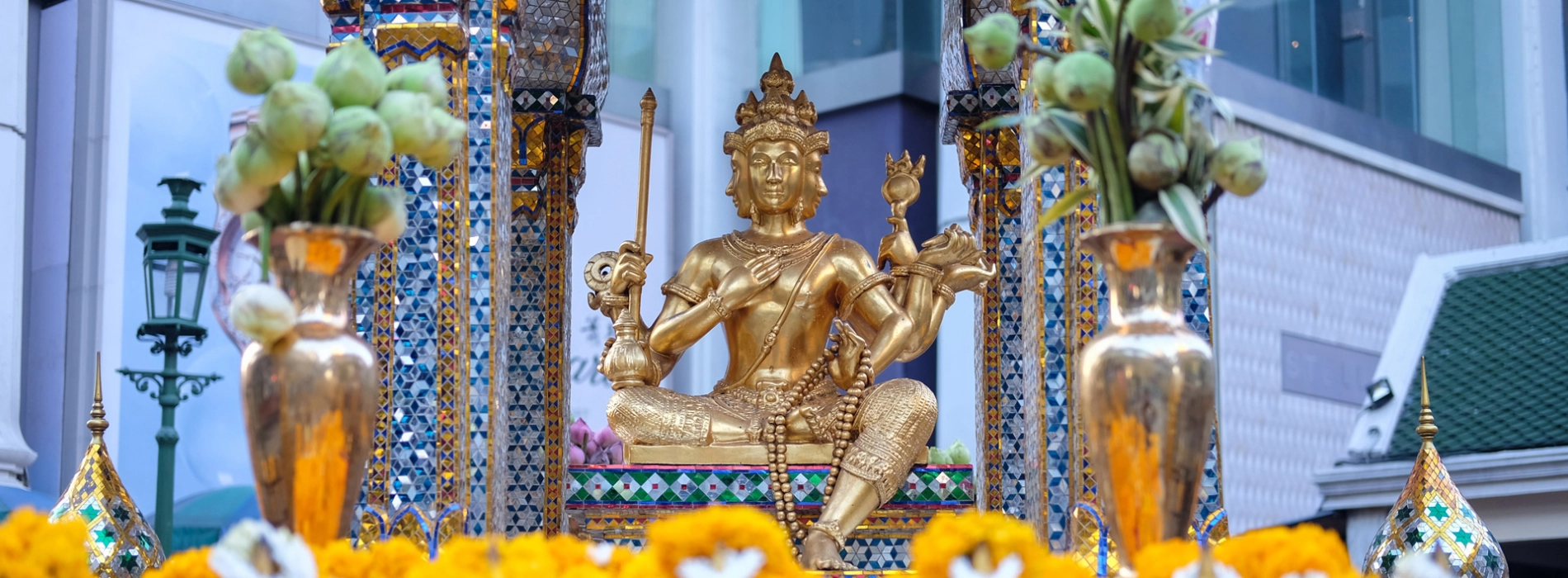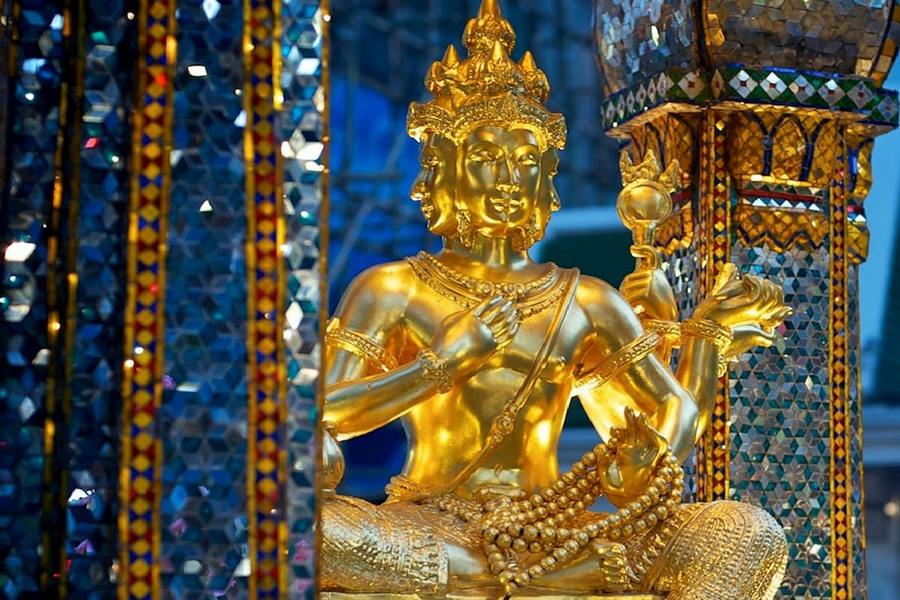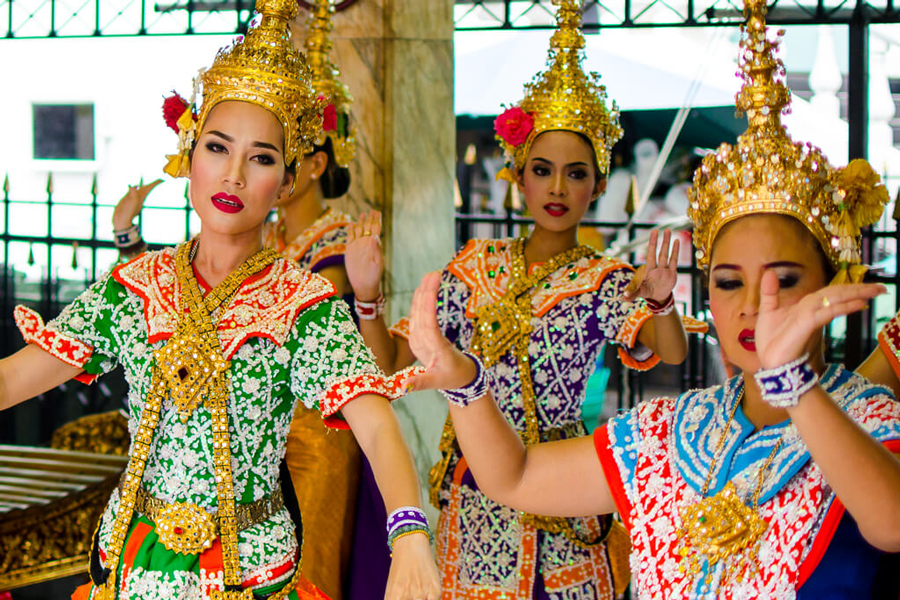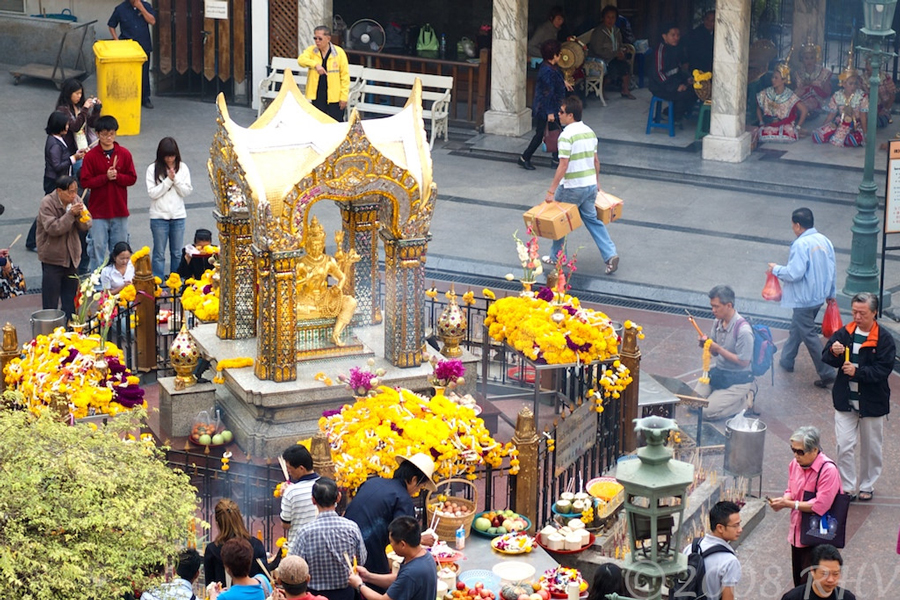Erawan Shrine

The Erawan Shrine, situated at the bustling Ratchaprasong intersection in the heart of Bangkok, Thailand, holds a special place as a revered Hindu shrine dedicated to the god Brahma, known as Phra Phrom in Thai culture. Originally constructed in 1956 as part of the Erawan Hotel, the shrine gained prominence over time, drawing worshippers seeking blessings of good luck, success, and prosperity. Traditional Thai dance performances often accompany the religious rituals, contributing to the shrine's cultural significance. Despite a tragic bombing incident in 2015, the Erawan Shrine has been restored and remains a symbol of resilience, religious tolerance, and the coexistence of diverse beliefs in Thailand. Visitors and locals alike continue to flock to this sacred site to offer prayers and make offerings, reaffirming its enduring importance in the spiritual and cultural fabric of the country. Let's explore Erawan Shrine with Asia King Travel!
The Erawan Shrine's history dates back to the mid-1950s when the Thai government decided to build the Erawan Hotel at the Ratchaprasong intersection in Bangkok. During the hotel's construction, workers faced a series of challenges, accidents, and delays, which led to the belief that the project was plagued by bad luck and negative karma.
To counteract these perceived misfortunes, the decision was made to erect a shrine dedicated to the Hindu god Brahma, who is considered the creator of the universe in Hinduism. The Erawan Shrine was officially established in 1956 as part of the Erawan Hotel complex. The shrine's construction aimed to bring about positive spiritual energies and ensure the success and prosperity of the hotel.
The name "Erawan" refers to the three-headed white elephant, Airavata, which is the mount of Lord Indra in Hindu mythology. The shrine originally housed a golden Brahma statue, and people soon began to visit the site to pray for good fortune, success in business, and other positive outcomes.
Over the years, the Erawan Shrine gained immense popularity and became a focal point for worshippers, both locals and tourists alike. It played a role not only in Hindu rituals but also in Thai cultural and religious practices. Traditional dance performances and ceremonies became integral to the shrine's atmosphere, creating a unique blend of religious and cultural significance.
In 2006, the original Brahma statue was vandalized, leading to its replacement with a new one. The shrine underwent further renovations and enhancements, solidifying its status as a prominent landmark in Bangkok. Tragically, in 2015, a bomb exploded near the Erawan Shrine, resulting in casualties and international attention. The incident prompted increased security measures and a restoration of the shrine, underscoring its resilience and enduring importance in the hearts of the Thai people.
Today, the Erawan Shrine continues to be a symbol of faith, cultural heritage, and the harmonious coexistence of various religious traditions in Thailand. It stands as a testament to the country's rich history and the enduring power of belief in the face of challenges.
Erawan Temple worships the four-faced god
The four-faced Buddha in Thailand is highly revered, and almost every Vietnamese traveler visiting Bangkok also makes a pilgrimage to the Erawan Temple, considered the most sacred place for worshiping the four-faced Buddha in Thailand. Despite being called the four-faced Buddha, the statue does not belong to Buddhism but represents a four-sided deity, with each face corresponding clockwise from the front: Tu (praying for career and status), Bi (praying for marital relationships), Hy (praying for wealth and prosperity), and Xa (praying for health and peace).

The eight arms represent 8 different meanings
Meaning of the 8 arms of the four-faced Buddha
Activities at Erawan Shrine
When you visit Erawan Temple, you'll encounter numerous tourists from diverse nationalities and religions who come to the temple to burn incense and offer bows to the Four-Faced Buddha. Adjacent to the temple, traditional Thai dances are arranged, and visitors contribute money, all of which is subsequently donated to charitable causes.

Dancers adorned in colorful costumes create a lively and cultural atmosphere.
Transportation

BTS Skytrain in Bangkok
Entrance Fees: There is usually no entrance fee to visit the Erawan Shrine itself. However, if you choose to participate in any religious rituals, make offerings, or hire dancers for traditional performances, these may involve additional costs.
The best time to visit the Erawan Shrine in Bangkok is during the early morning or late afternoon to evening. This is based on both weather considerations and the cultural atmosphere surrounding the shrine.

Thai people come to offer incense at the Erawan Shrine
Morning Hours: Visiting the shrine in the morning allows you to experience it in a relatively peaceful and serene environment. The weather is typically cooler, and there are fewer crowds, providing a more intimate setting for prayer or quiet contemplation.
Late Afternoon to Evening: The late afternoon and evening are popular times to visit the Erawan Shrine, especially for those interested in witnessing traditional Thai dance performances that often take place in the vicinity. The atmosphere becomes vibrant, and the shrine is illuminated, creating a visually stunning setting.
Erawan Temple is situated in the Pathum Wan district. Visitors have the option to either use a taxi to reach the crossroads of Rajadamri and Ploenchit streets or take the Skytrain to Chitlom Station and then proceed to the temple from there